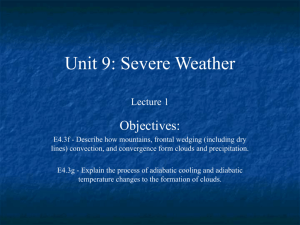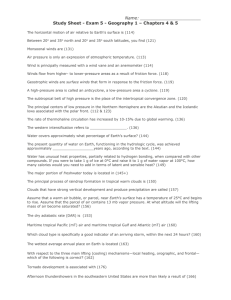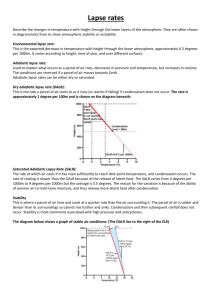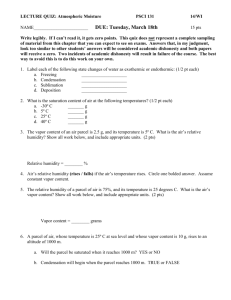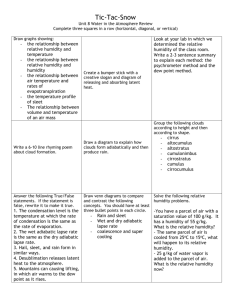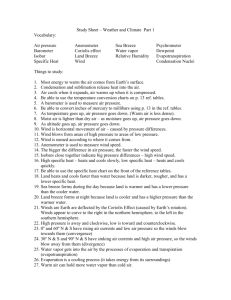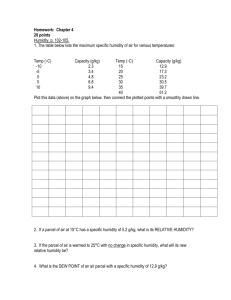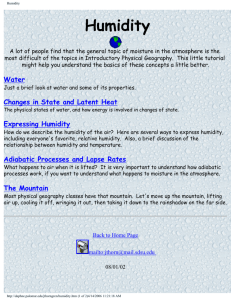Thursday, Feb. 27 - University of South Alabama
advertisement
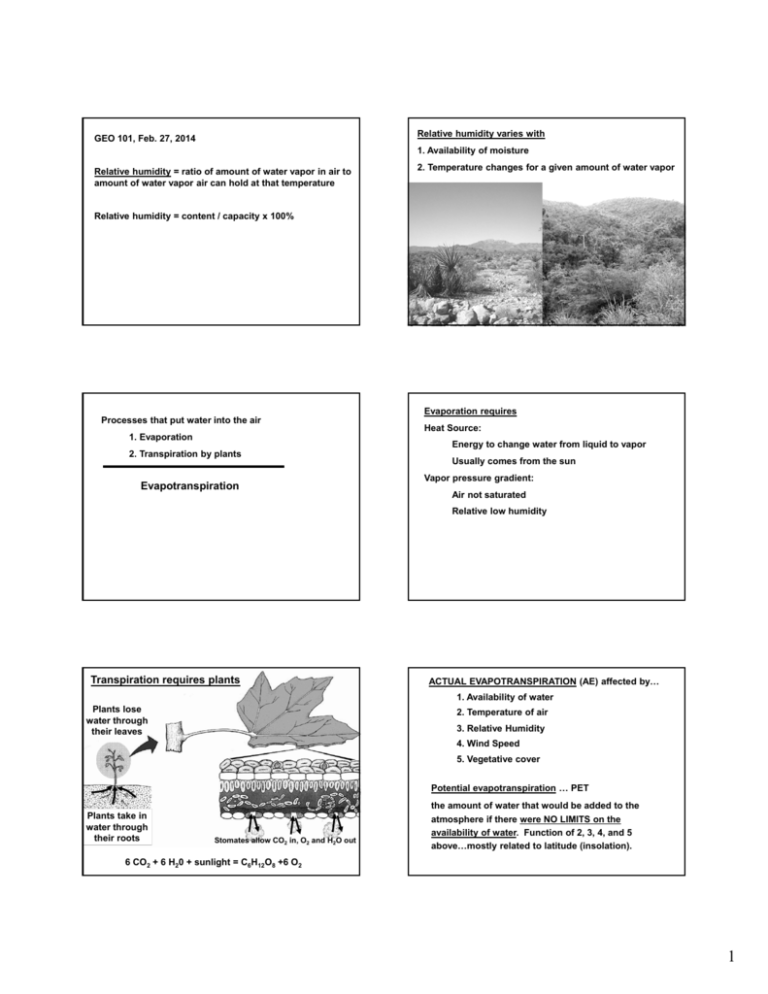
Relative humidity varies with GEO 101, Feb. 27, 2014 1. Availability of moisture Relative humidity = ratio of amount of water vapor in air to amount of water vapor air can hold at that temperature 2. Temperature changes for a given amount of water vapor Relative humidity = content / capacity x 100% Processes that put water into the air 1. Evaporation 2. Transpiration by plants Evapotranspiration Evaporation requires Heat Source: Energy to change water from liquid to vapor Usually comes from the sun Vapor pressure gradient: Air not saturated Relative low humidity Transpiration requires plants ACTUAL EVAPOTRANSPIRATION (AE) affected by… 1. Availability of water Plants lose water through their leaves 2. Temperature of air 3. Relative Humidity 4. Wind Speed 5. Vegetative cover Potential evapotranspiration … PET Plants take in water through their roots Stomates allow CO2 in, O2 and H2O out the amount of water that would be added to the atmosphere if there were NO LIMITS on the availability of water. Function of 2, 3, 4, and 5 above…mostly related to latitude (insolation). 6 CO2 + 6 H20 + sunlight = C6H12O8 +6 O2 1 Average Monthly Water Budget: Jackson, MS If cool saturated air, decrease capacity, air becomes over saturated, water vapor has to get out of air, condensation occurs. PET Precipitation AE Moisture surplus Moisture deficit Temperature at which condensation occurs = DEWPOINT CONDENSATION Soil moisture utilization affected by… 1) Relative humidity 2) Degree of cooling 3) Availability of nuclei Soil moisture recharge CONDENSATION DEW AND FROST Water vapor condenses or sublimates on a surface CONDENSATION CLOUDS AND FOG Water vapor condenses on nuclei Clouds form when air cools below its dewpoint meters Types of fog feet Radiation Advection Upslope Evaporation 2 Temperature structure of atmosphere = normal lapse rate “Normally” gets colder as you go up at ≈ 6.5°C per 1000 m Adiabatic processes: internal to a parcel of air PROCESS that cools air below dewpoint clouds Occurs when parcel of air is LIFTED up into atmosphere. Remember... meters °C Altitude in meters Surface inversion (starts at surface) Degrees Celsius Altitude in meters Temperature inversion: it gets warmer as you go up instead of getting colder like it is supposed to do. The normal lapse rate would be like having thermometers tied to a tall tower that reached to the top of the troposphere and taking a temperature reading at each thermometer at the same time. Inversion aloft starts above surface Degrees Celsius Atmospheric pressure decreases with increasing altitude 500 312 mi Adiabatic processes: internal to a parcel of air 400 Altitude (km) Air molecules 300 200 Air density 100 62 mi Air pressure 90% in first 10 mi 10 mi 3 Dry adiabatic rate ≈ 10°C per 1000 m -20 Vertically moving air parcels that are NOT SATURATED follow the dry adiabatic rate of temperature change when ascending or descending. 0 -10 10 Subtropical Highs air descends warms adiabatically 0 capacity to hold water vapor increases 20 relative humidity decreases Horse latitudes meters 30 10 °C Reminder: water vapor contains latent heat Dry adiabatic rate vs. normal lapse rate If air parcel is cooler than surrounding air, it will not rise = stable. If air parcel is warmer than surrounding air, it will rise = unstable. 20 24 25 25 27 30 meters °C As air cools, it can hold less water vapor. If cooled below saturation point, condensation occurs at dewpoint temperature. The altitude where this occurs is called the lifting condensation level. Clouds start here. Condensation releases energy to the surrounding environment. Dry adiabatic rate ≈ 10°C/1000m Wet (moist, satuated) adiabatic rate ≈ 5-6°C/1000m (Varies with moisture content, temperature, and pressure) Dewpoint Dewpoint = 20°C LCL = 1000 m meters °C 4 If parcel stays warmer than surrounding air, it will continue to rise Dewpoint meters °C WHAT YOU MUST KNOW ABOUT THE ADIABATIC PROCESS Normal or environmental lapse rate ≈ 6.5°C/1000m Can be inversions or variations Dry adiabatic rate = DAR ≈ 10°C/1000m Wet or saturated adiabatic rate = SAR ≈ 5-6°C/1000m Adiabatic rate is not the same as the normal (environmental) lapse rate. Normal (environmental) lapse rate = temperature structure of the atmosphere Adiabatic rates = temperature changes in a rising (cooling) or falling (warming) parcel of air. Parcel will only rise if it is warmer than the surrounding air! When rising parcel cools to dewpoint temperature Adiabatic cooling Condensation condensation starts and clouds form Condensation Clouds lifting condensation level Clouds Precipitation latent heat is released into the parcel Rain Sleet continued cooling is at the slower wet adiabatic rate Descending parcels warm at the dry adiabatic rate. 5 Hail Glaze Snow Snowflakes For adiabatic cooling to occur, air must rise via atmospheric lifting! Types of atmospheric lifting Reminder: Precipitable water vapor by latitude cm Frontal = warm goes up over cold air Convective = bubbles of warm wet air Capacity of air to hold moisture directly related to temperature Orographic = up a mountainside Convergent = air meets in a LOW 6 Latitudinal variation in precipitation Wind and pressure belt review Only every other person gets a worksheet Work WITH a partner to fill it out Put both of your names on the worksheet Try to reason your way through it without your notes Use your notes as a last resort Turn it in Know the lifting mechanisms, or lack thereof, that explain this latitudinal pattern 7
